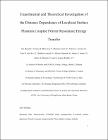| dc.contributor.author | Gounko, Iouri | en |
| dc.contributor.author | Bradley, Louise | en |
| dc.date.accessioned | 2014-07-22T09:23:07Z | |
| dc.date.available | 2014-07-22T09:23:07Z | |
| dc.date.issued | 2014 | en |
| dc.date.submitted | 2014 | en |
| dc.identifier.citation | Zhang, X, Marocico, CA, Lunz, M, Gerard, VA, Gun'ko, YK, Lesnyak, V, Gaponik, N, Susha, AS, Rogach, AL, Bradley, AL, Experimental and Theoretical Investigation of the Distance Dependence of Localized Surface Plasmon Coupled Forster Resonance Energy Transfer, ACS NANO, 8, 2, 2014, 1273-1283 | en |
| dc.identifier.issn | 1936-0851 | en |
| dc.identifier.other | Y | en |
| dc.identifier.uri | http://hdl.handle.net/2262/70455 | |
| dc.description | PUBLISHED | en |
| dc.description | This paper was identified by the Target Selection Team at Advanced in Engineering as a Key Scientific Article contributing to excellence in engineering, scientific and industrial research. It featured in Advanced in Engineering in December 2014. | en |
| dc.description.abstract | The distance dependence of localized surface plasmon (LSP) coupled Förster resonance energy transfer (FRET) is experimentally and theoretically investigated using a trilayer structure composed of separated monolayers of donor and acceptor quantum dots with an intermediate Au nanoparticle layer. The dependence of the energy transfer efficiency, rate, and characteristic distance, as well as the enhancement of the acceptor emission, on the separations between the three constituent layers is examined. A d–4 dependence of the energy transfer rate is observed for LSP-coupled FRET between the donor and acceptor planes with the increased energy transfer range described by an enhanced Förster radius. The conventional FRET rate also follows a d–4 dependence in this geometry. The conditions under which this distance dependence is valid for LSP-coupled FRET are theoretically investigated. The influence of the placement of the intermediate Au NP is investigated, and it is shown that donor–plasmon coupling has a greater influence on the characteristic energy transfer range in this LSP-coupled FRET system. The LSP-enhanced Förster radius is dependent on the Au nanoparticle concentration. The potential to tune the characteristic energy transfer distance has implications for applications in nanophotonic devices or sensors. | en |
| dc.format.extent | 1273-1283 | en |
| dc.language.iso | en | en |
| dc.relation.ispartofseries | ACS NANO | en |
| dc.relation.ispartofseries | 8 | en |
| dc.relation.ispartofseries | 2 | en |
| dc.rights | Y | en |
| dc.subject | Förster resonant energy transfer | en |
| dc.subject | localized surface plasmons | en |
| dc.subject | localized surface plasmons | en |
| dc.subject | colloidal metal nanoparticles | en |
| dc.subject | nanocrystals | en |
| dc.subject | quantum dots | en |
| dc.title | Experimental and Theoretical Investigation of the Distance Dependence of Localized Surface Plasmon Coupled Forster Resonance Energy Transfer | en |
| dc.type | Journal Article | en |
| dc.type.supercollection | scholarly_publications | en |
| dc.type.supercollection | refereed_publications | en |
| dc.identifier.peoplefinderurl | http://people.tcd.ie/bradlel | en |
| dc.identifier.peoplefinderurl | http://people.tcd.ie/igounko | en |
| dc.identifier.rssinternalid | 95187 | en |
| dc.identifier.doi | http://dx.doi.org/10.1021/nn406530m | en |
| dc.rights.ecaccessrights | openAccess | |
| dc.identifier.orcid_id | 0000-0002-9399-8628 | en |




